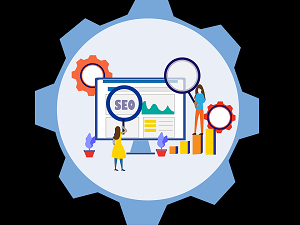The Long-Term Impact of SEO on Business Growth and Sustainability
 Building a strong online presence is essential for long-term success in today's digital landscape. For CEOs, business owners, and decision-makers, an effective SEO strategy goes beyond short-term gains and paves the way for sustainable growth. Let's delve into three critical areas where SEO impacts business performance over the long term and what steps you can take to enhance your company's digital presence.
Building a strong online presence is essential for long-term success in today's digital landscape. For CEOs, business owners, and decision-makers, an effective SEO strategy goes beyond short-term gains and paves the way for sustainable growth. Let's delve into three critical areas where SEO impacts business performance over the long term and what steps you can take to enhance your company's digital presence.
1. Building Brand Awareness by Improving Organic Traffic
When customers search for specific terms related to your services or products, SEO helps align your website with those search terms, increasing your chances of appearing prominently in search results. This visibility is essential: the majority of searchers only interact with the top few results on a search engine results page (SERP).
For example, suppose your business offers professional tree services, including “trimming” and “pruning.” By integrating relevant keywords into your site, your content becomes more likely to match search queries like "professional tree services." According to the Search Engine Journal, more than 28% of organic search clicks go to the first result, while the numbers fall significantly for lower-ranking results.
Why Organic Traffic Matters More Than Paid Ads
Unlike paid ads, which deliver results only while the ad campaign is active, SEO has a compounding effect. Each piece of optimized content you publish builds over time, improving your brand's visibility with each passing month. Once established, your optimized content attracts organic visitors consistently, even without ongoing ad spend.
To maximize your organic traffic:
- Focus on quality content: Create informative, engaging, and relevant content that speaks directly to your audience's needs.
- Use accurate keywords and eliminate "negative" keywords: Exclude irrelevant keywords that don’t align with your brand to improve relevance.
- Optimize meta tags and descriptions: A well-optimized meta description entices searchers to click through.
Organic traffic fuels brand awareness and visibility, acting as a sustainable source of leads and conversions.
2. Increasing Brand Credibility Through Authority Building
SEO is not just about visibility; it’s about building trust. When your business ranks highly for relevant searches, customers are more likely to see you as an industry authority. Trust, in turn, leads to credibility, making potential customers more inclined to choose you over competitors.
Establishing Authority with Quality Content and Link Building
High-quality content that addresses specific client pain points or industry trends can establish your brand as a go-to source for reliable information. For example, a manufacturing company can provide insights into industry best practices, or an accounting firm might publish resources on tax changes. Additionally, other websites often link to credible sources of information, meaning that valuable content can result in backlinks from other industry leaders, further boosting your credibility.
- Develop comprehensive guides: Create detailed resources that showcase your expertise.
- Earn backlinks: Other sites linking to your pages acts as endorsements, enhancing your reputation in search engine algorithms.
The more authoritative your content and the more credible your link profile, the stronger your site’s reputation becomes, leading to better rankings, increased trust, and, ultimately, more customers.
 3. Enhancing User Experiences to Improve Conversion Rates
3. Enhancing User Experiences to Improve Conversion Rates
A critical aspect of SEO often overlooked is its impact on user experience (UX). Even if your SEO efforts lead people to your site, it’s essential that they stay and engage. User experience has a significant impact on your rankings, and Google actively prioritizes sites that offer a seamless browsing experience.
Common User Experience Barriers
Several UX factors can lead to a high bounce rate, where visitors leave shortly after arriving:
- Slow page load times: If your site takes more than a few seconds to load, visitors are likely to leave. Research shows that about 48% of users will abandon a page if it doesn’t load within six seconds.
- Mobile friendliness: With a large portion of internet users browsing on mobile devices, a responsive design that adapts to all screens is vital.
- Navigation and layout: An intuitive, easy-to-navigate site structure makes it simple for visitors to find what they need.
Improving user experience not only reduces bounce rates but also increases the likelihood of conversions. Google’s algorithm rewards sites with a positive user experience, meaning these adjustments are essential for both SEO and overall business success.
 How to Improve User Experience for SEO Benefits
How to Improve User Experience for SEO Benefits
To enhance UX, focus on:
- Optimizing page speed: Compress images, minimize code, and leverage browser caching to improve load times.
- Creating a responsive design: Ensure your site adapts to all devices, including smartphones and tablets.
- Simplifying navigation: Organize your content logically, so visitors can find information quickly.
Better user experiences contribute to higher engagement, longer site visits, and increased conversions—all of which feed back into SEO success and long-term growth.
SEO Takes Time but Offers Lasting Impact
One of the most important things to remember about SEO is that it’s a long-term investment. Unlike short-lived ad campaigns, which require continual funding and often yield temporary results, SEO builds a solid foundation that delivers ongoing returns. This patience pays off as your content, backlinks, and user experience improvements compound over time.
- Regularly update your SEO strategy: Algorithms change frequently, and staying updated with best practices helps maintain rankings.
- Monitor metrics and adjust as needed: Use tools like Google Analytics to track traffic, bounce rate, and other key indicators.
- Invest in long-term relationships with SEO specialists or agencies: Professional expertise can be instrumental in maintaining your competitive edge.
By focusing on sustainable, long-term strategies, your SEO efforts become an integral part of your growth strategy, driving consistent results that fuel your company’s success.
Top FAQs Answered:
1. How long does it take to see the impact of SEO on my business?
The timeline for SEO impact can vary based on factors like competition, industry, and the quality of your strategy. Generally, you can expect initial results within 3-6 months, with more substantial growth within a year as your efforts compound. SEO is a long-term strategy, but consistent efforts and regular content updates yield lasting benefits.
2. Can I rely on SEO alone for online visibility?
While SEO is a powerful tool for organic visibility, it’s best used alongside other digital marketing strategies like content marketing, social media engagement, and paid advertising. These tactics complement SEO, creating a multi-channel approach that drives traffic and enhances brand visibility from various angles.
3. What are some key metrics to track for SEO performance?
Tracking SEO success involves monitoring metrics such as organic traffic, bounce rate, keyword rankings, and conversion rate. Tools like Google Analytics and Google Search Console offer insights into how visitors find your site, which keywords are driving traffic, and how well users engage with your content. Monitoring these metrics allows you to refine your strategy and identify areas for improvement.
By prioritizing a long-term SEO strategy, businesses can enhance brand awareness, establish credibility, and improve user experiences, all of which fuel sustainable growth and position them as industry leaders.
